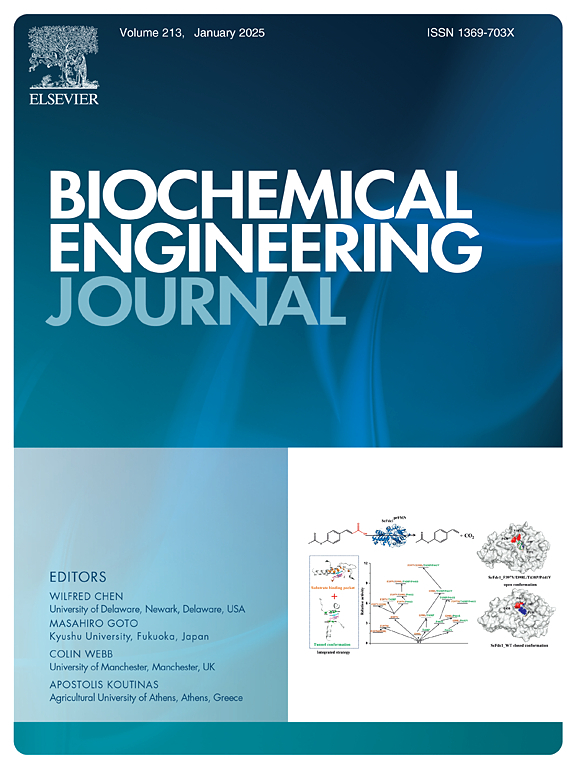不同硫氮比条件下四环素对混养反硝化过程的影响
IF 3.7
3区 生物学
Q2 BIOTECHNOLOGY & APPLIED MICROBIOLOGY
引用次数: 0
摘要
以硫为基础的自养-异养反硝化作用,即混养反硝化作用,适用于在低化学需氧量(COD)-氮(C/N)比条件下去除养殖尾水中的硝酸盐和抗生素。本研究主要探讨了四环素(TC)在不同信噪比条件下对混养反硝化作用的影响。在不同的硫氮(S/N)比(3.94、4.64 和 5.94)条件下,同时运行两个生物反应器,是否投加四环素。结果表明,随着硫氮比的升高,总无机氮(TIN)的去除率从 0.25 mg N L-1 min-1 提高到 0.69 mg N L-1 min-1,而四环素的投加量则显著降低了总无机氮的去除效率。在暴露于 TC 的情况下,检测到了分解氮还原氨(DNRA)细菌,这表明 DNRA 对 TC 有更强的抵抗力。反硝化系统对 TC 的去除率在信噪比为 4.64 时达到最高,为 22.87%。同时,在这一阶段检测到了马林杆菌属,这有利于有机污染物的降解。本研究发现,在信噪比为 5.94 时,TC 促进了氨氮的积累,并对硫自养菌有很大影响。TC 的去除主要依赖于微生物的协同代谢,TC 浓度的降低与硫化合物的减少之间存在显著相关性(p <0.05)。4.64 是混养反硝化过程的最佳信噪比,它显示了最大的硝酸盐和 TC 去除率。本文章由计算机程序翻译,如有差异,请以英文原文为准。
Impact of tetracycline on mixotrophic denitrification process under different sulfur to nitrogen ratios
The sulfur-based autotrophic-heterotrophic denitrification, i.e., mixotrophic denitrification, is suitable for the nitrate and antibiotics removal in aquaculture tailwater at a low COD to nitrogen (C/N) ratio. This study focused on the effect of tetracycline (TC) on mixotrophic denitrification under different S/N ratios. Two bioreactors were simultaneously operated with or without dosing tetracycline under different sulfur to nitrogen (S/N) ratios of 3.94, 4.64 and 5.94. The results showed that the removal rate of total inorganic nitrogen (TIN) increased from 0.25 to 0.69 mg N L−1 min−1 with the rise of S/N ratio, while TC dosage significantly declined the removal efficiency of TIN. Dissimilatory nitrogen reduction to ammonia (DNRA) bacteria was detected when exposing to TC, indicating that DNRA presented more resistance to TC. The removal efficiency of TC in the denitrification system reached the maximum of 22.87 % at S/N of 4.64. Meanwhile the genus Marinicella was detected at this phase, which was conducive to the degradation of organic pollutants. This study found that TC promoted the accumulation of ammonia nitrogen, and had a great effect on sulfur autotrophic bacteria at S/N of 5.94. The removal of TC mainly depended on microbial co-metabolism, and there was a significant correlation between the reduction of TC concentration and the decrease of sulfur compounds (p < 0.05). 4.64 is the best S/N ratio for the mixotrophic denitrification process, which revealed maximum nitrate and TC removal rates.
求助全文
通过发布文献求助,成功后即可免费获取论文全文。
去求助
来源期刊

Biochemical Engineering Journal
工程技术-工程:化工
CiteScore
7.10
自引率
5.10%
发文量
380
审稿时长
34 days
期刊介绍:
The Biochemical Engineering Journal aims to promote progress in the crucial chemical engineering aspects of the development of biological processes associated with everything from raw materials preparation to product recovery relevant to industries as diverse as medical/healthcare, industrial biotechnology, and environmental biotechnology.
The Journal welcomes full length original research papers, short communications, and review papers* in the following research fields:
Biocatalysis (enzyme or microbial) and biotransformations, including immobilized biocatalyst preparation and kinetics
Biosensors and Biodevices including biofabrication and novel fuel cell development
Bioseparations including scale-up and protein refolding/renaturation
Environmental Bioengineering including bioconversion, bioremediation, and microbial fuel cells
Bioreactor Systems including characterization, optimization and scale-up
Bioresources and Biorefinery Engineering including biomass conversion, biofuels, bioenergy, and optimization
Industrial Biotechnology including specialty chemicals, platform chemicals and neutraceuticals
Biomaterials and Tissue Engineering including bioartificial organs, cell encapsulation, and controlled release
Cell Culture Engineering (plant, animal or insect cells) including viral vectors, monoclonal antibodies, recombinant proteins, vaccines, and secondary metabolites
Cell Therapies and Stem Cells including pluripotent, mesenchymal and hematopoietic stem cells; immunotherapies; tissue-specific differentiation; and cryopreservation
Metabolic Engineering, Systems and Synthetic Biology including OMICS, bioinformatics, in silico biology, and metabolic flux analysis
Protein Engineering including enzyme engineering and directed evolution.
 求助内容:
求助内容: 应助结果提醒方式:
应助结果提醒方式:


